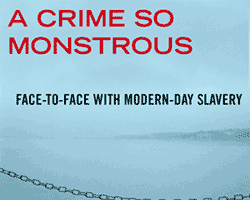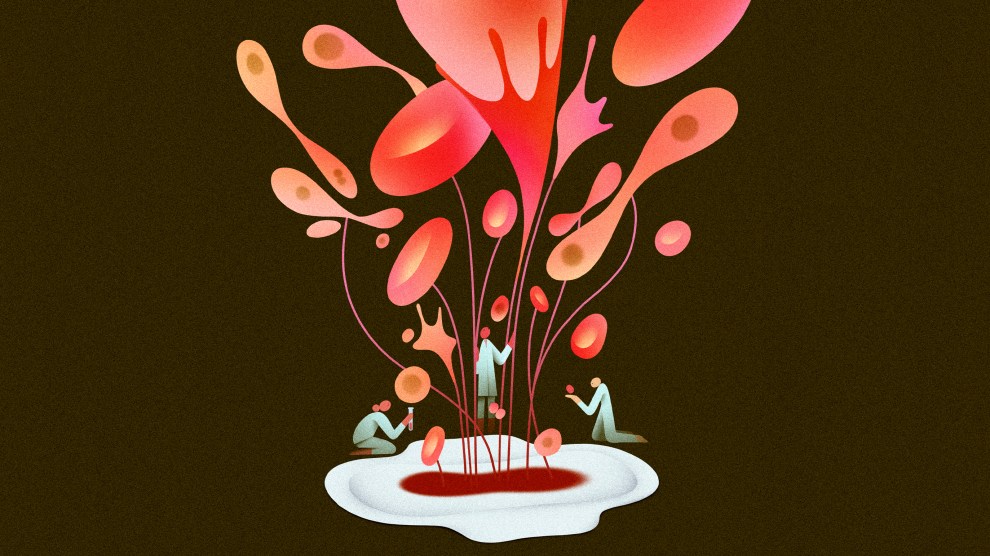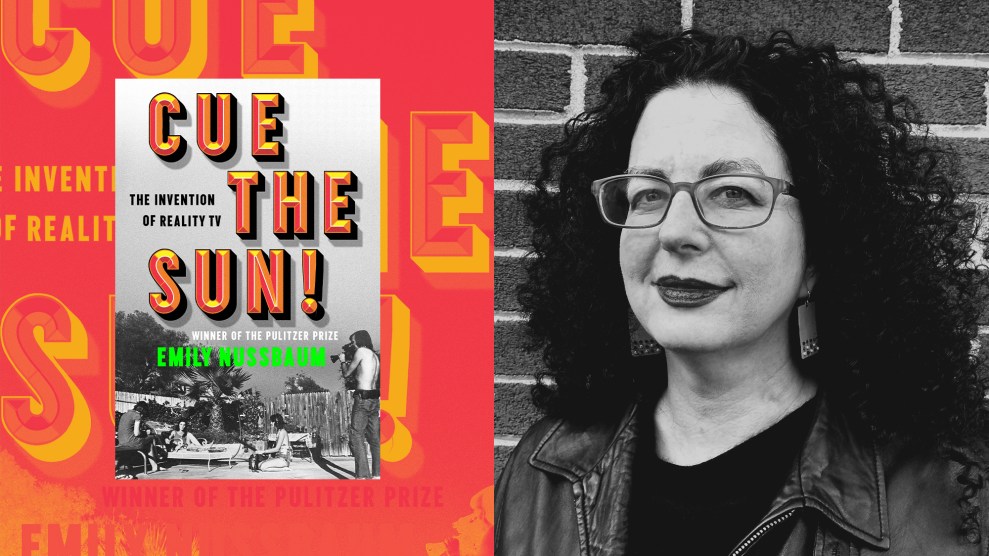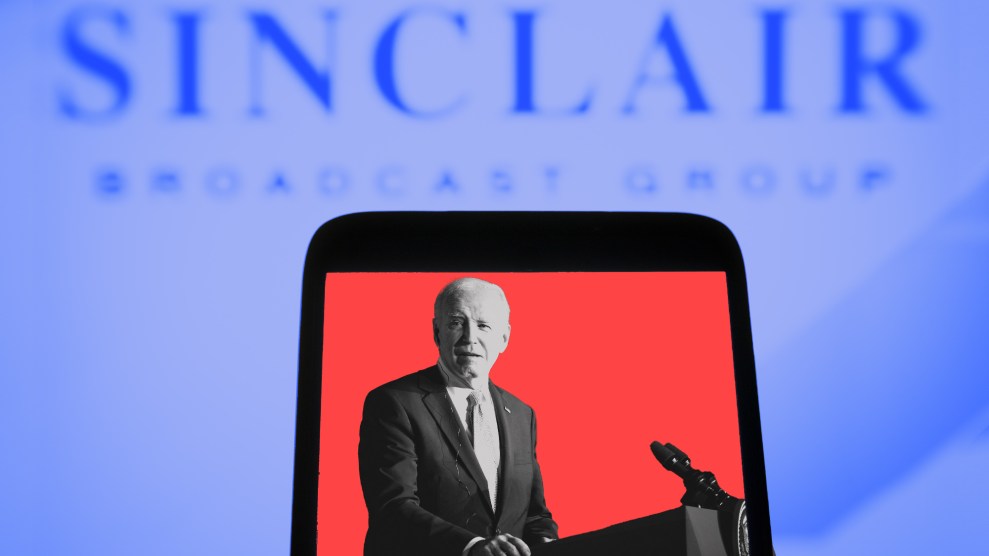
Eliot Spitzer’s high-priced prostitute, Kristen, is not a slave; she’s a prostitute. Or so says Benjamin Skinner, author of the new book A Crime So Monstrous: Face-to-Face With Modern-Day Slavery. Skinner’s opinion is informed by his definition of “slave”: someone who is forced to work, under threat of violence, for no pay beyond subsistence.
Going by this definition and the desire to humanize one of the globe’s most devastating injustices, he spent the past five years traveling between five continents to infiltrate slave trafficking networks—at times negotiating sales undercover (but never buying human life)—and collecting the searing stories of more than 100 victims.
The point of the book is loud and clear: Slavery is far from dead, and there’s not enough being done about it. There are more slaves in the world today than at any other point in history, with estimates ranging from 12 to 27 million, and we’re not talking about those laboring for less than a dollar a day in developing countries or choosing to charge thousands for an hour of intimacy. The statistic refers only to those who truly have no choice.
Skinner took time to speak with Mother Jones from his home in Brooklyn about how some evangelicals and a small subset of academic feminists have distorted America’s already skewed understanding of slavery, the hypocrisy of the Bush administration’s soaring anti-slavery rhetoric, and what constitutes the “typical” slave.
Mother Jones: Why does it come as such a shock that there are more slaves in the world today than ever before?
Benjamin Skinner: My sense is that there is a fundamental misunderstanding, particularly in America, of what slavery is. The term has lost its currency and so you get the artist formerly known as Prince writing the word slave on his cheek to protest a binding contract that pays him 10 million per album. You get people using the word slave to refer to those who are underpaid in sweatshops but can walk away.
MJ: You point out in your book that American politicians have chosen to focus very narrowly on combating only sex slavery. What percentage of slaves in the world is actually in the sex trade?
BS: Anytime you’re talking about numbers of slaves it gets difficult because slaves don’t stand in line and raise their hands to have their census taken. The best estimates that we have are that 15 out of 16 slaves today are not enslaved in commercial sex. The typical slave is a woman between the ages of 12 and 40, South Asian, and in some form of debt bondage, typically generational. Beyond that, the slave would likely be on a farm or in some low-level industry—brick making, fishing, that kind of thing.
MJ: And in the United States?
BS: The studies that have been done show that the United States is not representative of slavery in the world—that a plurality of slaves in the U.S. are sex slaves. Not a majority but a plurality. But again, this is just based on those cases that we’ve discovered. Because the Justice Department is so focused on finding sex trafficking, ‘it’s going to find more people enslaved in commercial sex than in other industries.
MJ: How many slaves are there in the U.S. altogether?
BS: The Justice Department and State Department’s estimate—which I think is probably ballpark—is that every year, 14,500 to 17,500 are trafficked in. At any one time there are about 50,000.
MJ: So who is behind the U.S.’s narrow focus on commercial sex?
BS: Academic feminists and evangelical conservatives have been able to push through an expansion of what trafficking means to encompass all prostitution whether it’s coerced or not. So you get this very Washington academic idea that all prostitutes are slaves and all slaves are prostitutes.
For the record, I think prostitution is always degrading and exploitative and it is often brutal, but it is not always slavery. Those who argue that it is, however well meaning they may be, are doing tremendous damage by diminishing the suffering and pulling attention away from the millions of people in the world who are slaves, not to mention those who are genuinely enslaved in prostitution. If you make this a law about prostitution and not about slavery, the cops are going to go after the low-hanging fruit.
MJ: Can you give an example?
BS: The first place the cops will go is to the Village Voice—they’ll go through every escort service and haul ’em all in and arrest them. Simple, job done. Now, what they’re missing are all the people in Florida held in trailers around the migrant camps. Girls that are trafficked in and raped 15 times a day and not paid anything and infected with all sorts of diseases. I mean, that’s slavery! But this Kristen—you know the Eliot Spitzer girl—that’s not slavery. How, under this new legislation that just passed the House, is the victimization of a girl—and I’m thinking about a particular one, who all she had was a 6 by 8 room in a trailer, a soiled mattress, and a roll of toilet paper that she had turned into a kind of teddy bear—the same as that of Kristen, who is making over $1,000 an hour sleeping with the governor of New York? The answer is that it’s not the same and yet this law attempts to paint both with the same brush.
MJ: In your book, you discuss how evangelicals and feminists chose to fight only prostitution and sex slavery.
BS: You know, I asked Richard Land—one of the most powerful evangelicals in the country and therefore the world—whether he’d spoken out against debt bondage. He leaned back and said, “You know, I have but I haven’t formed a campaign around it. You have to be able to paint pictures.” I took that to mean that it’s just not an interesting picture to show someone who is beaten regularly but enslaved in a cotton field or a brick kiln. It’s much more interesting to talk about a woman, and let’s be frank, when you see the images they are particularly of white women who are enslaved in some form of brutal prostitution.
And the feminists don’t give a damn about those enslaved in agriculture or low-level industries.
MJ: And how have evangelicals reacted to your book so far?
BS: Evangelicals have actually embraced the book and I have to give them a lot of credit for that. They tend to say, ‘We may disagree on some of the details but we’re both doing God’s work.”
MJ: Your book follows John Miller’s career as director of the State Department’s Office to Monitor and Combat Trafficking in Persons. At the end, he resigns in frustration.
BS: In order to keep his job, he knew that he was going to have to keep this constituency of evangelicals happy. For the first couple years he did their bidding. While he remained close to that constituency, he started meeting people enslaved in forms other than commercial sex.
He went to India and, like me, was overwhelmed with the scale of bondage there, came back, and pressed for India to be held accountable by being demoted to the lowest tier of the rankings in the State Department’s report on how countries are dealing with slavery. He was rebuffed in 2006 by the deputy secretary, Bob Zoellick, who is now the head of the World Bank, and who clearly doesn’t give a damn about slaves, as far as I can tell. So Miller went directly to Condoleezza Rice and pled the case of India’s slaves to her and she, who herself is the descendant of slaves, turned her back and basically acted like Pontius Pilot. That was the point when he decided that was it for him. He resigned several months later.
Miller became disillusioned with the fact that the Bush administration talked such beautiful, soaring rhetoric and never acted. He said to me that, from Colin Powell to Condoleezza Rice, the rhetoric on modern-day slavery got better and the action got worse. Rice would give magnificent speeches, raising her hands to the firmament and talking about how America will fight modern-day slavery, and would then do nothing. And you can say, “Fine, we are in a time of war, and there are other concerns,” but I’m allowed to point out the hypocrisy of her making these claims of leading an abolitionist America into a new century and then not doing anything about it.
MJ: Religion clearly plays an enormous role for many people who are combating slavery; did it play a role in your decision to write this book?
BS: My earliest learning about slavery was in Sunday school, and that’s largely because I was raised Quaker and the Quakers were the original abolitionists. We learned as much about Frederick Douglass and Harriet Tubman as Jesus and Moses. Many people I’ve met worldwide have been motivated by their faith. But I should add that it’s not just one faith, and I think that after a certain point there’s got to be more than faith.
MJ: When reporting something like this, you’re dealing with organized crime. What were some of the dangers you faced?
BS: The people who really face danger are, first of all, the slaves, and secondly, those who work on the ground to free them. There was a dicey situation in Istanbul where I was going in not knowing much about the person I would be negotiating with to buy girls outright. It turns out the guy had just served four years for human trafficking. He was the point end of a Russian mob ring and he didn’t trust me immediately. I wasn’t wearing a wire in that situation—whereas in most I certainly was. I have a feeling that if I had been wired, he would have sensed it, patted me down, and I probably wouldn’t be here today.
MJ: How did you contact this guy?
BS: I had eight hours in Istanbul and I literally went to a tourist agency at the airport and said, “I’m interested in finding women; actually I’m looking to buy girls outright, to keep.” And the guy said, “Yeah, I can do that. I know a couple guys who sell girls.” He made some phone calls, and then we drove out and went to a brothel where I talked to the guy.
MJ: How did that situation end?
BS: We got fairly far along and my translator started freaking out. He said, ‘I have a family; this isn’t what I signed up for.” And basically we just ran out of time. By contrast, in Bucharest, I was offered a girl outright. I was shown the girl and was told I could take her in exchange for a used car.
MJ: How many traffickers did you speak with while researching this book?
BS: I spoke with about a dozen. But I wasn’t always purporting to buy slaves. Some of them were incarcerated for human trafficking.
MJ: How much of the time were you undercover?
BS: As little as possible. I really prefer to let everyone know why I’m asking them what I’m asking them. But there are those human traffickers who, if they’re not incarcerated, are not going to talk to me unless I go under some kind of subterfuge.
I thought a lot about it. If I was going undercover to talk with a survivor or victim of slavery, I think that would be unconscionable because I’m not allowing them informed consent to talk about something that was never their fault in the first place. I often went through intermediaries first and would explain to them what it was that I was doing. The good ones would be quite resistant to letting me talk with slaves until they absolutely trusted that I wasn’t going to be doing any kind of double victimization, taking the most salacious pieces, publishing their name, and walking away.
But when we’re talking about people who are enslaving others, I didn’t go into that with a second thought. The only thing I wanted to make sure of was that I was getting an unvarnished dialogue from them and that I wasn’t pulling anything out of them that they wouldn’t be doing otherwise.
MJ: What was your primary goal in writing this book?
BS: I’d read Kevin Bales’ excellent book Disposable People in 2000 and subsequently read some very detailed academic books. And I thought, I want to write a book that tells these stories in an interesting way, weaves the narratives together, and tells about the lives of slaves, not just in terms of the nuts and bolts, but presents some of the hope and the survival stories. I certainly dragged myself over the coals—and the lawyers at Simon & Schuster did as well—to make sure everything was on the up and up. But the academic rigor is the background, and what you see first is the tremendously compelling stories of survival as well as the tremendously horrendous tales of slavery.














